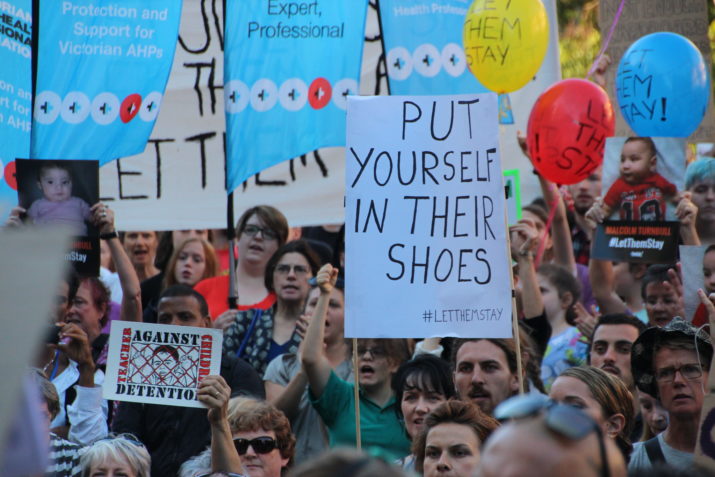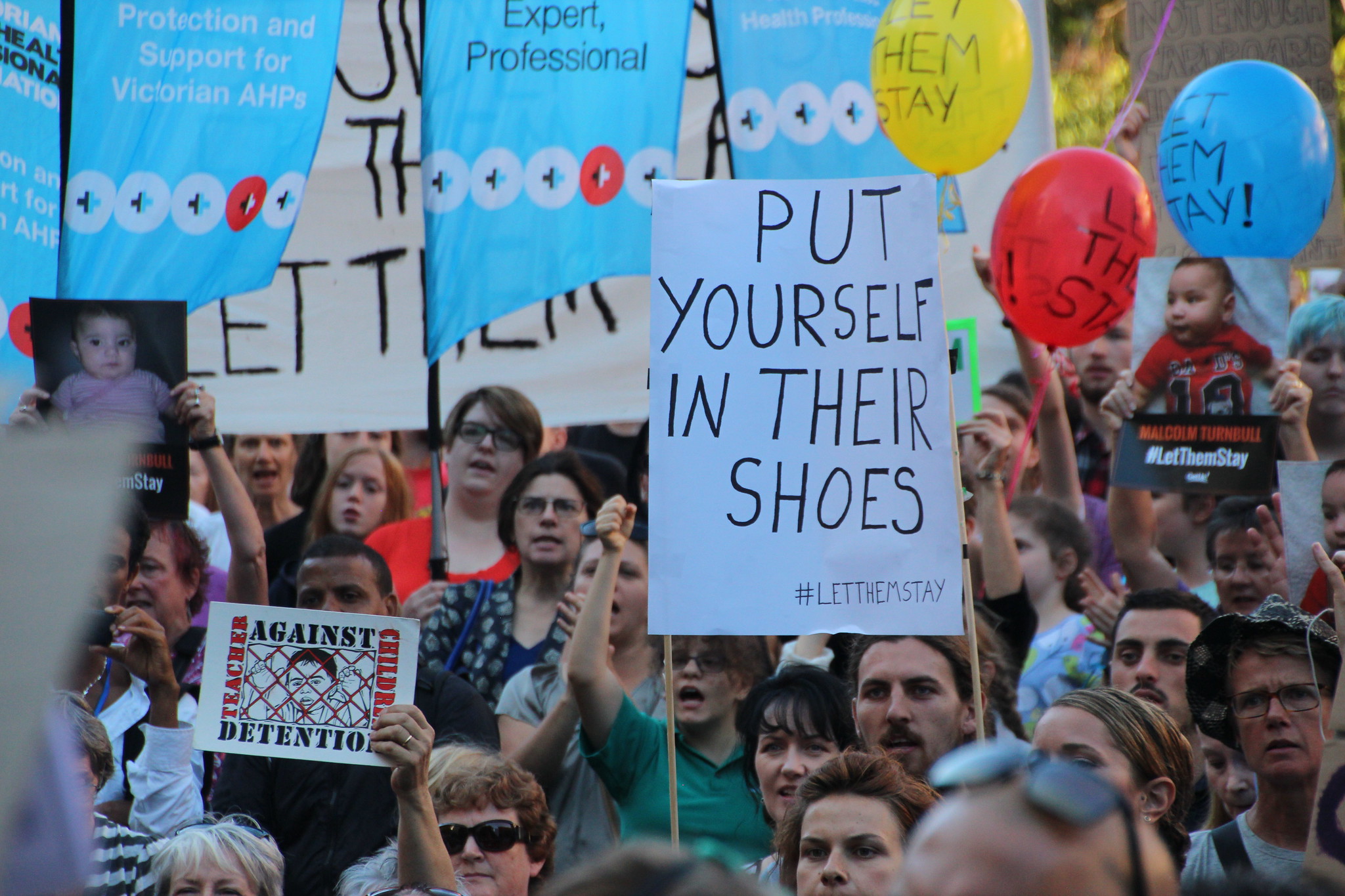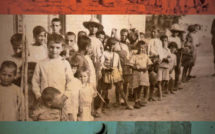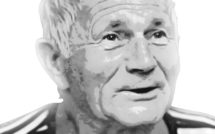

This is part of our special feature on forced migration, Narration on the Move.
This is part of our campus spotlight on Vassar College.
Nearly every news report and explanation of resignation syndrome (alternatively known as uppgivenhetssyndrom, RS, or traumatic withdrawal syndrome) begins the same way. Each explains the life of a child. The child is from a refugee family seeking asylum in Sweden (and, more recently, on the small island of Nauru) [1] and has been through extensive hardship. They are smart and charismatic and loved.[2] And then, slowly, they start breaking down: the do not talk, eat, or drink. They cease moving and opening their eyes and appear in a catatonic state for months or even years. The reporter explains that this child is one of many and that, besides appearing to have given up hope, there is little explanation for their health status.
The above description of RS creates an exciting story but not a comprehensive one. Despite studying a disease that many have decided to be culturally-bound, [3] there is little opportunity within existing discussions of RS to explore the implications of this label. In this article, I argue for a shift in the way that RS is researched. I advance this argument cautiously and with caveats. I do not intend to dismiss the difficulty of studying RS due to privacy rights, little medical precedent, limited journalist access, and moral codes. I also would not minimize the importance of individual narratives. I do, however, suggest that current writing on the subject offers an overabundance of medical explanations and a dearth of systemic analysis. To remedy this imbalance in the way that RS is discussed, I argue in favor of focusing on the refugee camp, rather than the patient, as the subject of research.
RS is a disease that seems to primarily affect refugee children. In his 2016 report, “Resignation Syndrome: Catatonia? Culture Bound?,” neuroscientist Karl Sallin writes that RS is identified as when a “depressive onset is followed by gradual withdrawal progressing via stupor into a state that prompts tube feeding and is characterized by failure to respond even to painful stimuli. The patient is seemingly unconscious.”[4] In a March 2017 National Public Radio (NPR) article, Susan Brink describes RS as having “become a culturally permissible way of expressing one’s despair.”[5] Georgi (the alias given to a young RS survivor in Sweden) explains that the illness felt like being trapped in a glass box in an interview with The New Yorker. He says, “At that time, it was very difficult, because every move could kill you.”[6]Georgi is not alone in this despair. Between 2003 and 2005, Sallin estimates that 2.8 percent of refugee children in his study were diagnosed with RS. [7] It has been suggested that roughly the same percentage of asylum seekers are afflicted with the condition in Nauru.[8] It is important to note here that the incidence of RS in Nauru is calculated from the entire population of asylum seekers, both children and adults, and therefore underestimates the percentage of children with RS. While children can often fully recover from RS, they exhibit symptoms for multiple years and need tube feeding for an average of six months. [9]
Though some historians have suggested that RS may have afflicted people in traumatic situations for many years (it has been suggested, for example, that people experienced similar symptoms in WWII concentration camps),[10] Sallin argues that RS appears to have boomed in the 1990s.[11] Until mid 2018, RS was generally assumed to have only existed in the refugee camps of Sweden. It has since been recorded and documented on the small island of Nauru. Studies of RS would benefit from increased interdisciplinary attention. Even the naming of RS has been debated since “psychiatrists disagree over whether resignation syndrome is a standard psychiatric diagnosis.”[12] The Swedish National Board of Health and Welfare define RS as its own unique condition.[13]
Though numerous studies, researchers, and journalists have attempted to define and explain RS, there are still many unanswered questions being asked about its triggering causes, the children’s susceptibility, and why it only seems to appear in these two locations. There has been a spike in media coverage of the condition since 2017 in articles including those in The New Yorker, The Economist, The Guardian, National Public Radio, ABC News, BBC News, Buzzfeed News, The Washington Post, The Huffington Post, and numerous others. These news sources reach vastly different audiences, demonstrating the wide interest in RS across the world. Framing RS as a fascinating, albeit upsetting, medical marvel has done little to tamper its prevalence within refugee communities. Its clickbait qualities mask some of the most significant questions: how do existing systems perpetuate refugee distress to the point that children can “give up?”[14] How has the politicization of these children’s health records distracted from the conditions which contributed to their illnesses in the first place? What is not being said?
Movement within the social sciences to study RS is needed to compliment medical diagnoses. One source that has done a good job of providing insight into the socio-political complexities of RS is the 2019 Netflix short documentary, Life Overtakes Me.[15] The documentary follows the families of three children afflicted with RS. While medical details are provided for context, the stories highlighted are those of each refugee family: the trauma they have experienced in the past, the instability of their futures, and the toll that caring for a child with RS has both physically and emotionally. In addition to interviewing a pediatrician and psychologist, the film also seeks insight form a journalist, immigration attorney, and the families of children with RS. It is clear by the end of the film that RS is intrinsically linked to the lived experiences and oppression of refugees within global political structures. Dr. Elizabeth Hultcrantz, M.D., PhD., explains in the film that she tells parents of children with RS that they are the ones suffering from their child’s condition. “She is not suffering,” Hultcrantz says. “Your child is laying here like Snow White because everything is so terrible around her that this is a way of protection. She is just waiting for the situation to be better.”[16] In agreement with Hultcrantz’sexplanation, one child – after over a year living with RS – has completely recovered by the end of the film following the news that her family has been granted residency. The film simultaneously suggests a bleak future and concern for RS amongst growing anti-immigrant sentiment.[17]
The fact that RS is attached to legal status has not been overlooked by all government officials. Many of these affected children are at risk of deportation and that as a result, Sweden’s Migration Board decided that families of those children should be granted residency permits.[18] The stress of deportation is a consistent factor in many of these cases.[19] Citing the Swedish Board of Health and Welfare, Aviv explains that “a permanent residency permit is considered by far the most effective ‘treatment’”of RS.[20] Meanwhile, an article published in The Lancet in October, 2018, stated that the Australian Medical Association’s President Tony Bartone said refugees are “detained because of political reasons” and that “their health and well-being is being put at risk” as a result.[21] The Australian government has denied this, yet in February, 2019, all children were evacuated from Nauru to Australia.[22]
The reports from Nauru are important to the study of RS both because they provide context but also because they serve to disprove some previously accepted hypotheses. Researchers in Sweden have suggested that susceptibility to RS is due in part to ethnicity, citing how the majority of Swedish cases have been found amongst those of minorities, particularly the Uighur ethnic group.[23] Yet, in Nauru, the majority of refugees are from different countries and of different ethnic groups than in Sweden. The majority of asylum seekers in Nauru come from Iran and Sri Lanka.[24]
Some journalists have attempted to capture the feelings and observations of children at risk of RS. Reporting from the Center for Investigative Reporting, Olivia Rousset explained in a February 2019 episode of Reveal that RS in Nauru is a “contagion of despair.”[25] Rousset interviews a young girl, Maya, about RS. Maya explains that she is aware of children with severe mental illnesses and RS on Nauru, including her own sister. She says Nauru is “not a place for kids” and that they are “getting so sick and tired of staying here.” She continues, “every single day of our life we wake up, it’s the same day. Nothing is changed. Fence, rocks, and tents. That’s all there is.”[26] If one chooses to believe Maya and if RS can indeed spread like a contagious disease, perhaps it is not where the refugee children come from but rather who they see and interact with that influences their likelihood of getting RS. Rousset reports that Maya later suffered from RS herself.[27]
One form of interaction that has been highly scrutinized is that between the parent and child with RS. It is often the parents of these children who are both blamed for their child’s sickness and credited with their recovery. In “Life-threatening Loss of Function in Refugee Children: Another Expression of Pervasive Refusal Syndrome?” Goran Bodegard examines the role of the child’s mother in the development of their resignation syndrome. Because of “the fixed behavior of the mothers- staging a delusion/fantasy that the child was dying…interpreted as a desperate coping strategy,” Bodegard concludes that the mental health of mothers is a determining factor in the health of children and that “improvements of the children were not noticed until the mothers gave up this ‘lethal’ mothering.”[28] Yet not every analysis of RS blames the parents. “The recovery of these children is dependent on rebuilding hope,” pediatrician Henry Ascher, M.D., explains in Life Overtakes Me. “And it seems that the parents are the persons transmitting this hope.”[29]The influence of parents on children with RS is therefore clear but not decisively negative or positive.
In calling for the protection of a child’s health, the United Nation’s “Convention on the Rights of the Child” states that in addition to considering the duties of legal guardians, “institutions, services, and facilities responsible for the care or protection of children shall conform with the standards established by competent authorities, particularly in the areas of safety, health.”[30] Why, then, are researchers not fully examining these systems within which the children receive care?
The answer is, in part, political. A study published in The International Journal of Social Psychiatry in August, 2018, explains that “the so-called ‘apathetic children’ become a [Swedish] political question in the midst of an increasing debate about the consequences of immigration in Sweden, where, according to Census 2010, approximately 15 percent of population is immigrant.”[31] Likewise, the article published in The New Yorker states that “these children are embedded in a moral and political debate that is central to the country’s identity complete with heroes (doctors), victims (patients), and villains (those who doubt the victim’s suffering).”[32] This statement is important because it mimics the oft-binary thoughts of a child and conveys the intensity of the situation.[33] It also highlights the fact that many of these cases are doubted and dismissed by those in powerful positions. Yet even this thought – while progressive and productive in some ways – continues to perpetuate the narrative that RS exists as a mysterious story. Much of the work needed to understand RS must begin with unpacking its stigmas.[34]
Through focusing research on the refugee camp, social scientists and medical practitioners alike will be able to gain insight into the true implications of a culturally-bound disease. They will be able to tell the complete story of each child without making the patient an outlying political example. This work will open doors for productive, concrete social action for preventing further cases of RS while simultaneously explaining the geographical mysteries of RS as they stand today. Most importantly, redirecting research towards the refugee camp and communities will ask the hard questions which will ultimately illuminate RS and provide justice to the “victims” and “heroes” whose stories may or may not have been heard yet. Medical explanations are needed and interesting, but do not complete the story. Resignation syndrome does not always have to be a mystery.
Ava McElhone Yates is a junior history major and Hispanic studies correlate (minor) at Vassar College. From Easthampton, MA, she serves as a co-coordinator for the Consortium on Forced Migration, Displacement, and Education. Her primary areas of interest are migration and international human rights as they intersect with gender studies.
References
Aviv, Rachel. “The Trauma of Facing Deportation,” The New Yorker, March 27, 2017, https://www.newyorker.com/magazine/2017/04/03/the-trauma-of-facing-deportation
Brink, Susan. “In Sweden, Hundreds of Refugee Children Gave Up On Life.” National Public Radio, March 30, 2017, https://www.npr.org/sections/goatsandsoda/2017/03/30/521958505/only-in-sweden-hundreds-of-refugee-children-gave-up-on-life.
Bodegard, Goran. “Life-threatening Loss of Function in Refugee Children: Another Expression of Pervasive Refusal Syndrome?,” Clinical Child Psychology and Psychiatry (July 1, 2005): https://doi.org/10.1177/1359104505053753.
Santiago, Iago Sávyo Duarte. “Resignation Syndrome in hidden tears and silences,” International Journal of Social Psychiatry (August 3, 2018): https://doi.org/10.1177/0020764018792595.
“Convention on the Rights of the Child,” entry into force 2 September 1990, United Nations Human Rights Office of the High Commissioner, https://www.ohchr.org/en/professionalinterest/pages/crc.aspx.
Doherty, Ben. “’Begging to die’: succession of critcically ill children moved off Nauru,” The Guardian, 24 August 2018, https://www.theguardian.com/australia-news/2018/aug/25/begging-to-die-succession-of-critically-ill-children-moved-off-nauru.
Gangi, Jane and Ellis Barowsky, “Listening to Children’s Voices: Literature and Arts as Means of Responding to the Effects War, Terrorism, and Disaster” Childhood Education International Focus (2009). 357-363.
Karlsen, Elibritt. “Australia’s offshore processing of asylum seekers in Nauru and PNG: a quick guide to statistics and resources.” Parliament of Australia, Law and Bills Digest Section, 19 December 2016, https://www.aph.gov.au/About_Parliament/Parliamentary_Departments/Parliamentary_Library/pubs/rp/rp1617/Quick_Guides/Offshore#_Nationalities_of_asylum.
Kwai, Isabella. “Australia Says Last Refugee Children Held on Nauru Will Go to U.S.” New York Times, February 3, 2019, https://www.nytimes.com/2019/02/03/world/australia/nauru-asylum-children-us.html.
Life Overtakes Me. Directed by Kristine Samuelson and John Haptas. USA: Netflix, June 14, 2019.
McCall, Chris. “Urgent medical attention needed for people on Nauru.” The Lancet (27 October 2018): https://www.thelancet.com/journals/lancet/article/PIIS0140-6736(18)32627-8/fulltext.
Rousset, Olivia. “Five years on Nauru,” Reveal, The Center for Investigative Reporting in collaboration with the Australian Broadcast Corporation, February 16, 2019, audio, 53:19, https://www.revealnews.org/episodes/five-years-on-nauru/.
Sallin, Karl and Hugo Lagercrantz, Kathinka Evers, Ingemar Engstrom, Anders Hjern, and
Predrag Petrovic, “Resignation Syndrome: Cataonia? Culture-Bound?,” Frontiers in Behavioral Neuroscience (29 January 2016): https://www.frontiersin.org/articles/10.3389/fnbeh.2016.00007/full.
Sydney, E.W. “What is resignation syndrome?,” The Economist, October 24, 2018,
https://www.economist.com/the-economist-explains/2018/10/24/what-is-resignation-syndrome.
[1] It is important to note here that given the fact that RS was seldomly recorded outside of Sweden until recently (discussed further in my paper), the assumption by the majority of cited authors is that RS exists in isolation. There are many references to Swedish culture which may or may not be relevant in the modern or future study of this condition. In addition to the geographic changes, it is simultaneously important to understand that the information provided by these sources is ever-changing. Small contradictions are for that reason inevitable amongst the full texts cited in this paper.
[2] Many of the individual children highlighted in the articles about RS are children well-known in their communities, such as Georgi who was described by journalist Rachel Aviv as a boy whose ‘doctor described him as “the most ‘Swedeified’ in his family.’” She continues to say, “He was also one of the most popular boys in his class. For his thirteenth birthday, two friends listed some of the qualities that he evoked: energetic, fun, happy all the time, good human being, amazingly kind, awesome at soccer, sly.”
Rachel Aviv, “The Trauma of Facing Deportation,” The New Yorker, March 27, 2017, https://www.newyorker.com/magazine/2017/04/03/the-trauma-of-facing-deportation.
[3] Karl Sallin, Hugo Lagercrantz, Kathinka Evers, Ingemar Engstrom, Anders Hjern, and Predrag Petrovic, “Resignation Syndrome: Cataonia? Culture-Bound?,” Frontiers in Behavioral Neuroscience (29 January 2016): 9-10. https://www.frontiersin.org/articles/10.3389/fnbeh.2016.00007/full.
[4] Sallin, “Resignation Syndrome.” 1.
[5] Susan Brink, “In Sweden, Hundreds of Refugee Children Gave Up On Life.” National Public Radio, March 30, 2017, https://www.npr.org/sections/goatsandsoda/2017/03/30/521958505/only-in-sweden-hundreds-of-refugee-children-gave-up-on-life.
[6] Aviv, “The Trauma.”
[7] Sallin, “Resignation Syndrome.” 8.
[8] Chris McCall, “Urgent medical attention needed for people on Nauru.” The Lancet (27 October 2018): 1508. https://doi.org/10.1016/S0140-6736(18)32627-8.
[9] Ibid.
[10] E.W. Sydney, “What is resignation syndrome?,” The Economist, October 24, 2018, https://www.economist.com/the-economist-explains/2018/10/24/what-is-resignation-syndrome.
[11] Sallin, “Resignation Syndrome.” 9-10.
[12] McCall, “Urgent medical attention needed.” 1508.
[13] Sallin, “Resignation Syndrome.” 2.
[14] Brink, “In Sweden.”
[15] Life Overtakes Me. Directed by Kristine Samuelson and John Haptas. USA: Netflix, June 14, 2019.
[16] Life Overtakes Me. 2019. 00:00:30.
[17] Life Overtakes Me. 2019.
[18] Susan Brink, “In Sweden.”
[19] Aviv, “The Trauma.”
[20] Ibid.
[21] McCall, “Urgent medical attention needed.” 1508.
[22] Ben Doherty, “’Begging to die’: succession of critically ill children moved off Nauru,” The Guardian, 24 August 2018, https://www.theguardian.com/australia-news/2018/aug/25/begging-to-die-succession-of-critically-ill-children-moved-off-nauru.
Isabella Kwai, “Australia Says Last Refugee Children Held on Nauru Will Go to U.S.” New York Times, February 3, 2019, https://www.nytimes.com/2019/02/03/world/australia/nauru-asylum-children-us.html.
[23] Sallin, “Resignation Syndrome.” 3.
[24] Elibritt Karlsen, “Australia’s offshore processing of asylum seekers in Nauru and PNG: a quick guide to statistics and resources.” Parliament of Australia, Law and Bills Digest Section, 19 December 2016, https://www.aph.gov.au/About_Parliament/Parliamentary_Departments/Parliamentary_Library/pubs/rp/rp1617/Quick_Guides/Offshore#_Nationalities_of_asylum.
[25] Olivia Rousset, “Five years on Nauru,” Reveal, The Center for Investigative Reporting in collaboration with the Australian Broadcast Corporation, February 16, 2019, audio, 53:19, https://www.revealnews.org/episodes/five-years-on-nauru/.
[26] Rousset, “Five years.”
[27] Ibid.
[28] Goran Bodegard, “Life-threatening Loss of Function in Refugee Children: Another Expression of Pervasive Refusal Syndrome?,” abstract, Clinical Child Psychology and Psychiatry (July 1, 2005): 337. https://doi.org/10.1177/1359104505053753.
[29] Life Overtakes Me. 2019.
[30] “Convention on the Rights of the Child,” entry into force 2 September 1990, United Nations Human Rights Office of the High Commissioner, https://www.ohchr.org/en/professionalinterest/pages/crc.aspx.
[31]Iago Sávyo Duarte Santiago, “Resignation Syndrome in hidden tears and silences,” International Journal of Social Psychiatry (August 3, 2018): 80. https://doi.org/10.1177/0020764018792595.
[32] Aviv, “The Trauma.”
[33] As articles such as “Listening to Children’s Voices: Literature and Arts as Means of Responding to the Effects War, Terrorism, and Disaster” explain, accessing the mind of a child in traumatic situations is important to their healing. Acknowledging that children are both allowed to feel and live how they do is just as important as providing access to other perspectives so long as the two exist in balance. For many children in refugee camps in Sweden and in Nauru, there is little hope of an alternative life. Often, legal status changes cause children who had once imagined an alternative life to believe they no longer have those options.
Jane Gangi and Ellis Barowsky, “Listening to Children’s Voices: Literature and Arts as Means of Responding to the Effects War, Terrorism, and Disaster” Childhood Education International Focus (2009). 357-363.
[34] These include the belief that victims are not believable and that RS is ultimately inexplicable, among others.
Photo: Put yourself in their shoes – Sanctuary rally | Flickr
Published on October 29, 2019.




